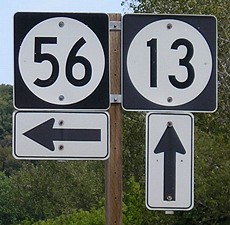

May 19, 2004 / September 7, 2006: There are only two places in Iowa where original 1920 numbers still meet in 2019 — IA 9/51 in Allamakee County and IA 13/56 in Clayton County. Neither intersection is in the same location it was a century ago.
Iowa’s Primary Road Act turns 100 years old today. It laid the groundwork for numbering, building, and maintaining the transportation system that this website is (mostly) about.
A long-ago typewritten report called “Iowa Roads: Historical Sketch of Developments in Administration 1838-1929” (large PDF) says this:
The Thirty-Eighth General Assembly in 1919 gave Iowa a long boost toward road improvement. The law established a primary road system of 6,400 miles; a Primary Road Fund to finance construction and maintenance; and a comprehensive plan by which the entire system was to be improved. The primary road system selected was the same as designated two years previously as the federal aid system though somewhat enlarged. It was specified that it should provide connecting highway links between all the larger towns and market centers. It did, in fact, link up practically every town of 1,000 population, or over.
From then until the Great Depression, counties and cities would determine if their roads would be paved and how much money would be spent on them. According to a 1950 piece about county-issued road bonds, the first two counties to have bond votes, Black Hawk and Palo Alto, went 1-1 on the issue. Greene County’s vote July 28, 1919, a scant 14 weeks after the law passed, would make the Lincoln Highway there a shining star in the Good Roads Movement (and for a decade, the only paved road between Madrid and Cushing). By early October, according to the Cedar Rapids Evening Gazette, 24 counties had “voted in favor of hard surfacing,” including almost all of the most populous, and nine against, including Tama and, ironically, Story.
Over the course of the next year or so the primary system would be figured out — this is why the state’s first road map is dated 1919 — and in the middle of July 1920 highway markers were painted on telephone poles across the state.
It wouldn’t be until 1925, though, that authority of maintenance of the primary roads would be put in the hands of the state, and not until 1938 that cities relinquished maintenance of highways within city limits. Authority over all county roads was given to supervisors on January 1, 1930.
This week is also the 115th birthday of what today is the Iowa Department of Transportation. It was established April 13, 1904, as the Iowa Highway Commission, part of the Iowa State College of Agriculture and Mechanical Arts. The first two men of the commission, Anson Marston and Charles F. Curtiss — the deans of the colleges of engineering and agriculture, respectively — have important buildings at Iowa State named for them today.
